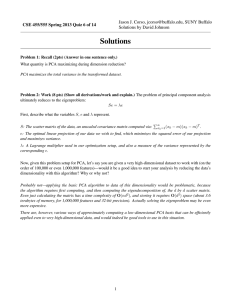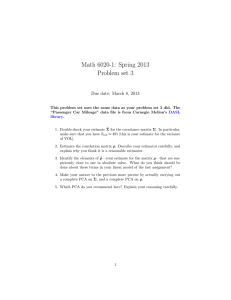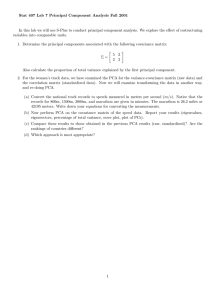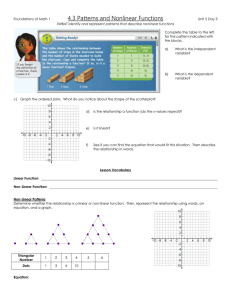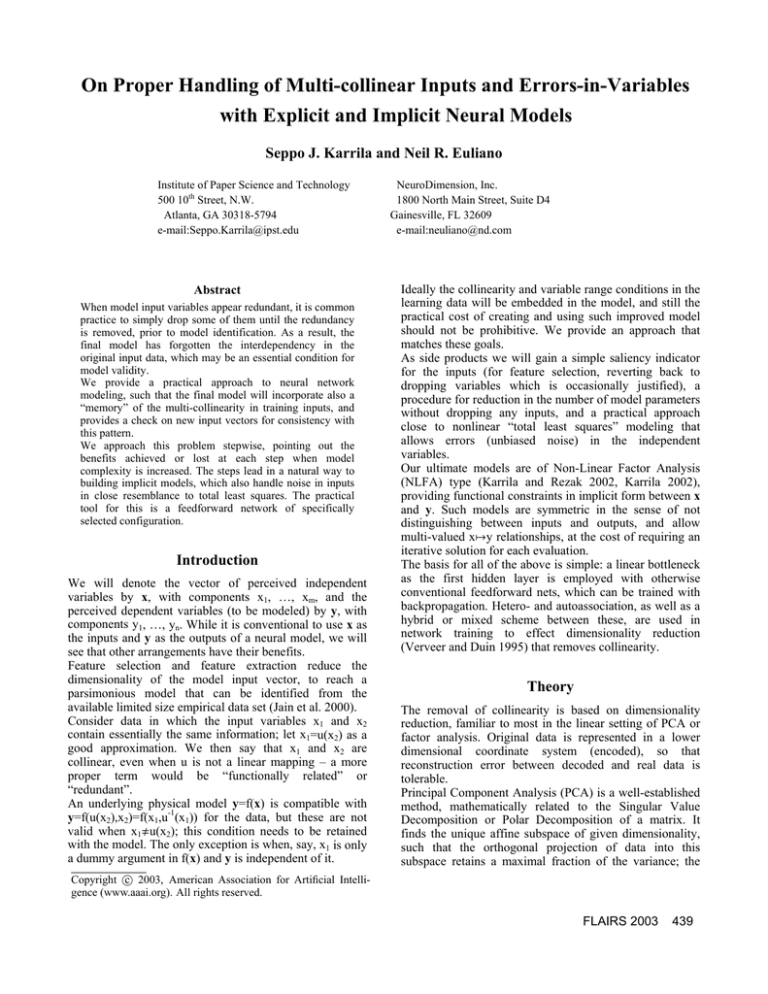
On Proper Handling of Multi-collinear Inputs and Errors-in-Variables
with Explicit and Implicit Neural Models
Seppo J. Karrila and Neil R. Euliano
Institute of Paper Science and Technology
500 10th Street, N.W.
Atlanta, GA 30318-5794
e-mail:Seppo.Karrila@ipst.edu
Abstract
When model input variables appear redundant, it is common
practice to simply drop some of them until the redundancy
is removed, prior to model identification. As a result, the
final model has forgotten the interdependency in the
original input data, which may be an essential condition for
model validity.
We provide a practical approach to neural network
modeling, such that the final model will incorporate also a
“memory” of the multi-collinearity in training inputs, and
provides a check on new input vectors for consistency with
this pattern.
We approach this problem stepwise, pointing out the
benefits achieved or lost at each step when model
complexity is increased. The steps lead in a natural way to
building implicit models, which also handle noise in inputs
in close resemblance to total least squares. The practical
tool for this is a feedforward network of specifically
selected configuration.
Introduction
We will denote the vector of perceived independent
variables by x, with components x1, …, xm, and the
perceived dependent variables (to be modeled) by y, with
components y1, …, yn. While it is conventional to use x as
the inputs and y as the outputs of a neural model, we will
see that other arrangements have their benefits.
Feature selection and feature extraction reduce the
dimensionality of the model input vector, to reach a
parsimonious model that can be identified from the
available limited size empirical data set (Jain et al. 2000).
Consider data in which the input variables x1 and x2
contain essentially the same information; let x1=u(x2) as a
good approximation. We then say that x1 and x2 are
collinear, even when u is not a linear mapping – a more
proper term would be “functionally related” or
“redundant”.
An underlying physical model y=f(x) is compatible with
y=f(u(x2),x2)=f(x1,u-1(x1)) for the data, but these are not
valid when x1∫u(x2); this condition needs to be retained
with the model. The only exception is when, say, x1 is only
a dummy argument in f(x) and y is independent of it.
NeuroDimension, Inc.
1800 North Main Street, Suite D4
Gainesville, FL 32609
e-mail:neuliano@nd.com
Ideally the collinearity and variable range conditions in the
learning data will be embedded in the model, and still the
practical cost of creating and using such improved model
should not be prohibitive. We provide an approach that
matches these goals.
As side products we will gain a simple saliency indicator
for the inputs (for feature selection, reverting back to
dropping variables which is occasionally justified), a
procedure for reduction in the number of model parameters
without dropping any inputs, and a practical approach
close to nonlinear “total least squares” modeling that
allows errors (unbiased noise) in the independent
variables.
Our ultimate models are of Non-Linear Factor Analysis
(NLFA) type (Karrila and Rezak 2002, Karrila 2002),
providing functional constraints in implicit form between x
and y. Such models are symmetric in the sense of not
distinguishing between inputs and outputs, and allow
multi-valued x#y relationships, at the cost of requiring an
iterative solution for each evaluation.
The basis for all of the above is simple: a linear bottleneck
as the first hidden layer is employed with otherwise
conventional feedforward nets, which can be trained with
backpropagation. Hetero- and autoassociation, as well as a
hybrid or mixed scheme between these, are used in
network training to effect dimensionality reduction
(Verveer and Duin 1995) that removes collinearity.
Theory
The removal of collinearity is based on dimensionality
reduction, familiar to most in the linear setting of PCA or
factor analysis. Original data is represented in a lower
dimensional coordinate system (encoded), so that
reconstruction error between decoded and real data is
tolerable.
Principal Component Analysis (PCA) is a well-established
method, mathematically related to the Singular Value
Decomposition or Polar Decomposition of a matrix. It
finds the unique affine subspace of given dimensionality,
such that the orthogonal projection of data into this
subspace retains a maximal fraction of the variance; the
c 2003, American Association for Artificial IntelliCopyright °
gence (www.aaai.org). All rights reserved.
FLAIRS 2003
439
extracted features are orthogonal projections to the axes
spanning this subspace. Factor Analysis can be considered
post-processing of the PCA results, by selecting a new,
possibly oblique, set of axes (approximately) spanning the
same subspace, often so that each of the feature values
(called scores) is referred back to a small subset of the
original variables.
On performing PCA all variables are treated
symmetrically; there are no inputs and outputs. Still the
final result can be viewed as a linear, total least squares
model – the squared deviations from a linear (or affine)
subspace in its normal direction have been minimized, and
some coordinates can be solved given others, based on the
“implicit model” that data lies in this subspace.
We will pursue similar traits in a non-linear setting, by
using neural networks as the engine that performs the
minimization of error.
A feedforward neural network processes a data vector
sequentially layer by layer. The outputs of any layer can be
viewed as encoded values, mapped to the outputs of the
network by the remaining layers. If the output target values
are equal to the inputs, the network is auto-associative.
Then the encoded values are approximately mapped back
to the inputs – the same network also embeds the decoding
mapping in its structure.
If an auto-associative neural network (AANN) is
successfully trained, it has learned encoding-decoding
mappings that preserve the original data vectors with only
a small reconstruction error (and when a validation set is
used, the ability to interpolate has also been tested during
training and network selection). If the AANN has a
bottleneck layer with a small number of nodes, the
encoding at this layer reduces the dimensionality of the
data vectors. This is how the bottleneck AANN structure
functions as a tool for data reduction.
An AANN with linear activation functions and only one
hidden bottleneck layer performs PCA. It finds the same
subspace as PCA would find for a given reduction of
dimensionality, but the factor loadings (weight vectors of
linear encoding) will not be orthogonal without postprocessing or special network constructs. An extensive
review is provided in a recent book (Diamantaras and
Kung 1996).
Kramer’s non-linear PCA (NLPCA) learns non-linear
mappings f and g to perform encoding and decoding.
These mappings are each represented by an NN with (at
least) one hidden sigmoidal layer, and when the two
networks are combined at the bottleneck so that the output
layer of f is the input layer of g, the AANN has (at least)
three hidden layers. The universal approximation property
of NN ensures that three hidden layers with enough nodes
in the first and third will always suffice, and this is the
configuration that Kramer originally presented (Kramer
1991). NN training becomes more difficult as network
depth is increased and even with convergence the weights
may be stuck to a local suboptimal error minimum – this
encourages to limit the network depth, but on occasions
increasing the number of layers is useful (Villiers and
Barnard 1992).
440
FLAIRS 2003
An invertible mapping applied to the reduced values can
be used to form new encoding-decoding pairs, so this nonlinear reduction is not unique (or user independent) like
linear PCA is. While Kramer discusses the application of
information theoretic principles to select the reduced
dimensionality, using the validation set seems to be a good
practical approach for avoiding over-fitting also with
AANN.
The NLPCA seems not to be popular in applications and
we take a step back from it. In the following we explore
the benefits of linear encoding, combined with nonlinear
processing of the reduced inputs.
Adding a linear bottleneck to an ordinary I/O
network; parsimony and saliency benefits
Feature selection is a particular case of linear mapping
x#Ax, with some rows of the identity matrix I dropped to
form A – preprocessing with a linear mapping not of full
rank is common in this form. The purpose is to reduce the
number of parameters in a neural model, and ensure that
the available training data is sufficient for “identification”.
The number of hidden nodes may be dictated by the nature
of the output, as each “ridge” in it requires at least one
sigmoidal hidden node – we consider the number of
sigmoidal hidden nodes r fixed.
Insert a linear bottleneck layer (i.e., the nodes pass on their
net activation as such) with p nodes after the input layer,
without biases so the mapping is linear and not general
affine. Prior to the sigmoidal layer there are now mp+pr+r
parameters, compared with earlier mr+r parameters. We
benefit if p<mr/(m+r) , or equivalently 2p<H where H is
the harmonic mean of m and r (the geometric mean
G=◊(mr) s H is a useful bound if m and r are of the same
order of magnitude). The bottleneck should then be tried
with p about H/2 (or G/2), and if small training error is
reached, smaller values of p can be tried. This constriction
in the network can be viewed as one sort of regularization.
The activations of the p<m bottleneck nodes can be
considered “indicators” that show the joint effects of
inputs. If the input variables have been normalized, the
weights to the bottleneck indicate relative strengths of
effects on the output(s). The weights act as a saliency
measure.
Mixed association to embed collinearity rules in
model and achieve total least squares fitting
If, as in the Introduction, x1=u(x2), then the linear
bottleneck Ax=x2 does not lose information from x; the
reconstruction of x=(u(x2),x2) will require a nonlinear
mapping. The universal approximation capability of the
network after the bottleneck ensures that x can be
(approximately) reconstructed (Barron 1993). Let us then
assign x∆y as the targeted output, i.e. add output nodes to
the previous model type.
The mapping u is now part of the network model, so the
input collinearity is embedded – the model calculates also
“corrected independent variables” that obey this
Implicit models and Non-Linear Factor Analysis
Consider full autoassociation with a linear bottleneck as
the first hidden layer. Now x∆y is both the input and
targeted output of the neural network. For brevity, we will
denote this set of variables by only x (as if dropping y
from the previous model type). The perceived independent
and dependent variables are now treated symmetrically. In
recent publications this network topology has been given
the name Non-Linear Factor Analysis (NLFA), as it
encodes to “score values” with linear “factor loadings” in
matrix A, and decodes non-linearly (Karrila and Rezak
2002, Karrila 2002).
The combination of linear encoding to reduced
dimensionality, and nonlinear decoding back to
approximate reconstruction, seems to have been neglected
prior to publication of the NLFA method. Viewing the
encoding and decoding as inverse mappings we might
assume that if one is linear so should be the other. Indeed,
if the decoding is linear, the encoding is given by its
pseudoinverse. However, our earlier example of
x#x2#x=(u(x2),x2) provides a natural linear encoding
with nonlinear decoding. It is easy to construct examples
of this type that will show the shortcomings of linear PCA
with nonlinear data.
We define the optimal result of linear dimensionality
reduction as follows, for the intrinsic smooth functional
relationship between all variables in x. To get a rigorous
definition, we consider a continuum of points (not a noisy
and discrete set of data records) that obey the underlying
relationship and form a manifold.
Definition of LRID. A manifold M in —m is linearly
reducible to dimension p, if there is a linear mapping A
into —p such that the restriction of A to M is bijective
(one-to-one). The linearly reducible intrinsic
dimensionality (LRID) of M is the smallest of such
values p.
If p<m, then data reduction is performed by the encodingdecoding pair x # Ax # x. Denoting the (non-linear)
decoding by g, x=g(Ax) for all x in M. If p=LRID, then A
must be onto —p and of full row rank, and AAT is
invertible, so the projection to support (orthogonal
complement of null space) can be calculated as given
earlier.
Going backwards from Kramer’s NLPCA, if we restrict
the encoding to be linear we have NLFA, and if we further
restrict also the decoding to be linear we have PCA.
Clearly the capacity to reduce data decreases with each
restriction, so NLFA is a compromise in complexity and
capacity between the two earlier methods – a semi-linear
method between fully linear and fully non-linear. There are
cases where the intrinsic dimensionality is strictly less than
the LRID, but in many practical cases the non-linearity is
“mild” and NLFA works very well.
To visualize a comparison between these methods, Figure
1 provides a taxonomy, which refines the conventional
classification of data reduction methods to linear and nonlinear. It is appropriate to categorize methods based on the
encoding and decoding types separately. With the addition
of the NLFA method to the arsenal, an approach exists for
every useful slot in this taxonomy.
Note that the NLFA provides a model x=g(Ax)=g(v),
which is implicit and can be used as follows. Given
enough components of x as vector Bx, we can numerically
solve Bx=Bg(v) for v, and get the remaining components
from g(v). Only g needs to be stored for model application,
and the collinearity check is whether a satisfactory v can
be found. Separate checking of ranges for components of x
can of course be done. When v lives in —2 we can visualize
g as contour plots.
Linear
DECODING
Nonlinear
Linear
collinearity, enabling checking or alerts if deviation from
given new independent variables (inputs to model) is large.
This “mixed” model between auto- and hetero- association
reaches our first goal. If the input nodes clip the input
ranges according to the span of the training data, the model
will also alert to extrapolation.
Neglecting the outputs y and restricting the mapping after
the bottleneck to linear, we recover the neural computation
of principal components of x. The support of A, namely
AT(AAT)-1A, projects x into that subspace which spans
maximal variance with dimensionality reduction to
rank(A). Alternatively, this subspace provides a linear
model that has been fit to the data in the total least squares
sense.
When a total least squares model is desired, the errors in
independent variables need to be observed in fitting the
model. With feedforward networks this only happens when
the independent variables are included in the outputs – an
error sum is formed only at the output layer.
In the next section we will further discuss what the linear
“encoding” bottleneck does in combination with a
nonlinear “decoding”.
ENCODING
Nonlinear
Principal
Useless, revert to
component
PCA
analysis (PCA)
NLFA
Kramer’s
NLPCA
Figure 1. Types of encoding and decoding are used to
create taxonomy of some constructive data reduction
methods. NLFA stands for Non-Linear Factor Analysis,
while NLPCA refers to Non-Linear PCA with neural
networks.
In the following summary the linear operator A serves as
an indication of a linear bottleneck layer with p nodes in
the first hidden position. Output approximating, say, target
x is denoted by x’. The independent and dependent
variables are components of x and y, respectively.
FLAIRS 2003
441
Model
type
I/O
plain
I/O
With
linear
feature
extraction
I/O
With
embedded
NLFA for
indep.
variables
only
Implicit
(NLFA)
NN dissected
Benefit & Cost
x# y’
Heteroassociative
x#Ax# y’
Heteroassociative
Baseline
x#Ax# x’∆y’
Mixed association
+ handles multicollinearity with
new inputs
+ errors-in-vars
- apparent
complexity up
x∆y#A(x∆y) # x’∆y’
Autoassociative
+ all of the above
benefits
+ x# y’ can be
many-valued in
an
implicit
model
- use of model
requires
iterations
+ parsimony
+ saliency estim.
- “extra” layer to
train
We model 10 pulp and paper characteristics with the
NLFA method. These are freeness (of pulp), breaking
length, Mullen burst factor, tear factor, Bekk porosity
(transformed with natural logarithm), Schopper fold
(transformed with natural logarithm), % stretch to failure,
light scattering coefficient, contrast ratio, and apparent
density.
Two state variables are found to conserve the measured
data within reasonable reproduction error. The lowest R2 –
value 0.88 is found on predicting stretch, mainly due to
inaccuracy in the measurement of this variable. With the
exception of natural logarithm of porosity (value 0.96) and
tear (0.97), the remaining variables have R2 –values around
0.99.
Only 8 sigmoidal nodes are needed in the second hidden
layer – the first has two linear nodes as stated above. There
are 40 data records, and 20% of these were held as
validation data during training. This is a typical case where
the number of data records is seemingly small compared
with the number of variables.
Table 1. Comparison of the model types discussed in the
order of increasing model complexity.
A numerical example; laboratory refining
data
Wood pulp for making paper is mechanically beaten or
refined, to soften and break the fibers. The type and
amount of refining can be observed through its effects on
measured properties of paper made in a “standard way”.
First principle modeling of these phenomena is intractable,
and empirical modeling is needed to gain insights.
Linear factor analysis has been applied (Howard, Poole
and Page 1994) to a published collection of data (Cottral et
al. 1954), of which we only inspect a subset. Up to the
point of rotating the principal components the results of
such analysis are user independent. Further background on
linear factor analysis (and principal component analysis)
can be found in the references of their publication.
They found 3 major factors and gave an interpretation for
each – with any method (including NLFA) one could
dispute where the cutoff in required reproduction error
should be; equally well four or five factors could have
been retained from PCA, but the available interpretations
happened to have a good match with only three factors.
Our data comes from Appendix I, Table 16, of the same
reference dating back to 1954. These data are for a
bleached sulphite pulp labeled “extra strong (green)”. Six
different types of beater were applied to the same pulp for
various periods of time, by different laboratories – due to a
duplication of the Lampen mill, there are seven “beating
curves”.
442
FLAIRS 2003
Figure 2. The reduced coordinates (v in the theory section)
trace distinct nearly parallel curves for each type of beater
device. Along each curve the amount of beating is varied.
Figure 3. The tear factor is shown as contours superposed
on the curves of Figure 2.
Graphics such as Figure 3 also serve as a check that no
sharp kinks or other anomalies have been introduced in the
model.
In terms of the fraction of variance explained, the NLFA
with reduction to two dimensions performs slightly better
than PCA with reduction to three dimensions. This is to be
expected when the functional dependencies between
variables are nonlinear. As an illustration of what goes on
here, the canvas of an umbrella can be poorly fit with a
linear subspace, so PCA will claim it is three-dimensional;
but only two parameters are needed to generate this surface
– a two-dimensional manifold. We expect that a semilinear method such as NLFA can gain acceptance, and
simultaneously far exceed the power of linear PCA in
practical applications. The NLFA method can be
considered an autoassociative variation of projection
pursuit (which ordinarily is heteroassociative).
Notes on practical application
The methods presented are based on conventional
feedforward networks with at least two hidden layers. The
first hidden layer is a linear layer with fewer nodes than
there are inputs. When total least squares type models are
generated, the perceived independent variables are
included as targeted outputs. In the mixed type (explicit)
modeling, this may have a “hints” or “multitask learning”
effect, which aids the network in learning to model the
dependent variables (Caruana 1997).
It has recently been shown that bypass connections from
the bottleneck to the output layer can improve
reconstruction of the inputs (Karrila 2002). Flexible
software that allows arbitrary network configurations,
based on Wan’s transposed network for backpropagation,
can be useful for further experimentation (Wan and
Beaufays 1996; Principe, Euliano and Lefebvre 2000).
The number of nodes needed in the bottleneck needs to be
found by experimentation. While PCA can from a single
calculation show the effect of any linearly reduced
dimensionality on reconstruction error, NLFA requires
separate (and perhaps repeated) training for each degree of
reduction. Software that allows running a “batch” where
the number of nodes in a hidden layer is sequentially
varied, and each network configuration is trained multiple
times, makes this process easy and automated for the user.
Conclusions
A linear bottleneck layer that learns to pre-process the
inputs to a NN during its training has several benefits,
especially when available data is limited and possibly
plagued by functional dependencies between variables.
Without autoassociation the benefits are in model
parsimony, linearly constructed reduced (indicator)
variables whose construction is easy to document, and in
evaluation of the saliency of the independent variables for
feature selection.
Explicit models that calculate the dependent variables in
one pass, given the independent ones, can be so
constructed that multi-collinearity in training data is
modeled and can be automatically checked for when the
model is applied with new input data. At the same time
noise in the input variables is observed during training, and
the fitting is reminiscent of total least squares.
Implicit models can be built by autoassociation of NLFA
type, when it is not clear that some variables depend on
others as single-valued functions. The application of
implicit models requires iterative numerical solution.
However, with continuous increase in computing power,
such cost of model evaluation decreases in proportion to
the value of better performing models. We anticipate that
implicit modeling will gain in popularity in the near future.
The progression from simple to more complex models can
serve as a step-wise approach to exploration in practical
data-driven-modeling.
References
Barron, A. 1993. Universal approximation bounds for
superpositions of a sigmoidal function. IEEE Trans. Information
Theory 39(3):930-945
Caruana, C. 1997. Multitask Learning. Machine Learning, 28:4175
Cottral, L., Stephansen, E., Tyden, A., Rosen, W., and Nybergh,
B., 1954. Comparative beating investigation with different
laboratory beating apparatus for pulp evaluation. Proc. Tech.
Sect., BPBMA 35(3):359
Diamantaras, K., and Kung, S. 1996. Principal Component
Neural Networks: Theory and Applications, NY: Wiley.
Howard, R., Poole, R, and Page, D. 1994. Factor analysis applied
to the results of a laboratory beating investigation. J. Pulp and
Paper Science 20(5):J137
Jain, A.K., Duin, R.P.W., Mao, J. 2000. Statistical Pattern
Recognition: A Review. IEEE Trans. Pattern Analysis and
Machine Intelligence 22(1):4-37
Karrila, S. 2002. Non-Linear Factor Analysis (NLFA) with
Feedforward Networks Performs Non-Linear Data Reduction
with Extraction of Linear Scores. In Computational Intelligence
and Applications, 9-15. Atlanta, GA: Dynamic Publishers, Inc.
Karrila, S., Rezak, S. 2002. Review, Developments and Pulp and
Paper Research Applications of Data Reduction with Neural
Networks. In Proceedings of TAPPI Paper Summit Meeting,
Atlanta, GA, March 4-6.
Kramer, M. 1991. Nonlinear principal component analysis using
autoassociative neural networks. AIChE J., 37(2):233-243.
Principe, J., Euliano, N., and Lefebvre, W., 2000. Neural and
Adaptive Systems. John Wiley and Sons.
Verveer, P., Duin, P. 1995. An evaluation of intrinsic
dimensionality estimators. IEEE Trans. Pattern Analysis and
Machine Intelligence 17(1):81-86
Villiers, J. de, Barnard, E. 1992. Backpropagation neural nets
with one and two hidden layers. IEEE Trans. Neural Networks
4(1):136-141
Wan, E., and Beaufays, F. 1996. Diagrammatic derivation of
gradient algorithms for neural networks. Neural Computation
8(1):182-201
FLAIRS 2003
443

